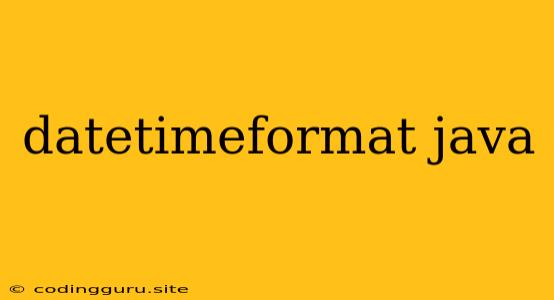Formatting Dates and Times in Java: A Comprehensive Guide
Java offers a robust and versatile way to work with dates and times through the java.time package, introduced in Java 8. However, understanding how to format these dates and times according to your desired output is crucial. This guide will explore the intricacies of datetimeformat in Java, providing you with the knowledge and tools to effortlessly customize date and time displays.
The Power of DateTimeFormatter
The cornerstone of date and time formatting in Java is the DateTimeFormatter class. This class provides a wide range of options for specifying the exact format you need.
How to use DateTimeFormatter
Let's start with a simple example:
import java.time.LocalDate;
import java.time.format.DateTimeFormatter;
public class DateFormatExample {
public static void main(String[] args) {
LocalDate today = LocalDate.now();
DateTimeFormatter formatter = DateTimeFormatter.ofPattern("dd/MM/yyyy");
String formattedDate = today.format(formatter);
System.out.println(formattedDate);
}
}
This code snippet demonstrates how to format a date in the "dd/MM/yyyy" pattern. The ofPattern method takes a string as input, which defines the desired format.
Understanding Format Patterns
The pattern string used in DateTimeFormatter.ofPattern follows specific rules. Here's a breakdown of common pattern letters:
| Letter | Meaning |
|---|---|
| y | Year |
| M | Month |
| d | Day of month |
| H | Hour of day (0-23) |
| h | Hour of day (1-12) |
| m | Minute |
| s | Second |
| S | Fractional second |
| a | AM/PM marker |
| E | Day of week |
| c | Era |
Example:
- "yyyy-MM-dd HH:mm:ss" -> "2023-12-25 15:30:55"
- "dd/MMM/yyyy" -> "25/Dec/2023"
Important Notes:
- Case sensitivity matters: "y" for year is different from "Y" for week-year.
- Some pattern letters can be combined: "yyyy" for full year, "yy" for two-digit year.
Predefined Formatters for Common Use Cases
DateTimeFormatter offers several pre-defined formatters for common date and time representations:
- ISO_LOCAL_DATE: "yyyy-MM-dd"
- ISO_OFFSET_DATE: "yyyy-MM-ddXXX" (including offset)
- ISO_LOCAL_TIME: "HH:mm:ss"
- ISO_OFFSET_TIME: "HH:mm:ssXXX" (including offset)
- ISO_DATE_TIME: "yyyy-MM-dd'T'HH:mm:ss"
- ISO_ZONED_DATE_TIME: "yyyy-MM-dd'T'HH:mm:ssXXX" (including zone)
Example:
import java.time.LocalDateTime;
import java.time.format.DateTimeFormatter;
public class PredefinedFormatterExample {
public static void main(String[] args) {
LocalDateTime now = LocalDateTime.now();
// Using ISO_DATE_TIME
String formattedDateTime = now.format(DateTimeFormatter.ISO_DATE_TIME);
System.out.println(formattedDateTime);
}
}
Handling Localization
When working with dates and times, it's important to consider the user's locale. Different languages and regions have distinct date and time formatting conventions. DateTimeFormatter provides a solution through withLocale.
Example:
import java.time.LocalDate;
import java.time.format.DateTimeFormatter;
import java.util.Locale;
public class LocaleExample {
public static void main(String[] args) {
LocalDate today = LocalDate.now();
// Using US locale
DateTimeFormatter usFormatter = DateTimeFormatter.ofPattern("MM/dd/yyyy").withLocale(Locale.US);
String usDate = today.format(usFormatter);
System.out.println("US Format: " + usDate);
// Using French locale
DateTimeFormatter frenchFormatter = DateTimeFormatter.ofPattern("dd/MM/yyyy").withLocale(Locale.FRENCH);
String frenchDate = today.format(frenchFormatter);
System.out.println("French Format: " + frenchDate);
}
}
Parsing Dates and Times
The DateTimeFormatter class is not only for formatting but also for parsing strings into date and time objects. The parse method performs this task.
Example:
import java.time.LocalDate;
import java.time.format.DateTimeFormatter;
public class ParseExample {
public static void main(String[] args) {
String dateString = "2023-12-25";
DateTimeFormatter formatter = DateTimeFormatter.ofPattern("yyyy-MM-dd");
LocalDate date = LocalDate.parse(dateString, formatter);
System.out.println(date);
}
}
Error Handling
When parsing strings, it's essential to handle potential errors. An invalid input string can lead to a DateTimeParseException.
Example:
import java.time.LocalDate;
import java.time.format.DateTimeFormatter;
import java.time.format.DateTimeParseException;
public class ErrorHandlingExample {
public static void main(String[] args) {
String dateString = "2023-12-25";
DateTimeFormatter formatter = DateTimeFormatter.ofPattern("yyyy-MM-dd");
try {
LocalDate date = LocalDate.parse(dateString, formatter);
System.out.println(date);
} catch (DateTimeParseException e) {
System.out.println("Invalid date format: " + e.getMessage());
}
}
}
Customizing Formatting
DateTimeFormatter offers a high degree of flexibility in customizing formatting beyond the basic pattern letters. It allows you to:
- Add literal text: Use single quotes to include literal text within the pattern. For example, "yyyy-MM-dd 'at' HH:mm:ss".
- Specify decimal places for seconds: Use "S" with a decimal count: "HH:mm:ss.SSS" for milliseconds.
- Define specific characters for separators: Use a single quote to escape the separator: "yyyy'#'MM'#'dd".
- Control case sensitivity: Use
ofPattern(pattern, Locale.ENGLISH, DateTimeFormatter.SENSITIVE)to make the pattern case-sensitive.
Conclusion
datetimeformat in Java provides a powerful and comprehensive framework for formatting and parsing dates and times. By mastering the DateTimeFormatter class, you gain the ability to control the exact representation of dates and times, catering to specific needs and user preferences. From simple date displays to complex time calculations, DateTimeFormatter empowers you to handle date and time data with ease and precision.
